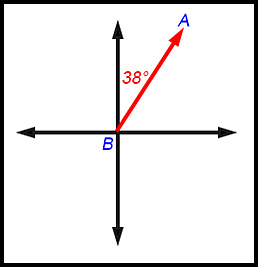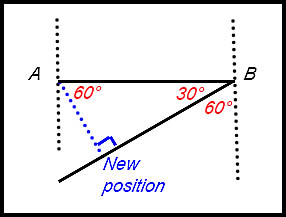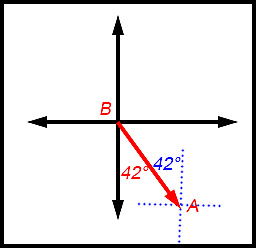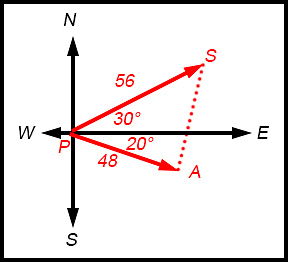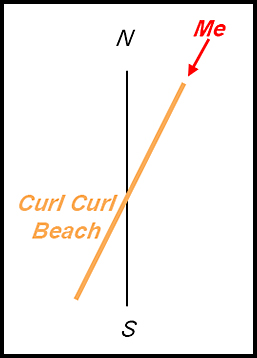Where the techniques of Maths
are explained in simple terms.
Trigonometry - Bearings (compass and true).
Test Yourself 1 - solutions.
- Algebra & Number
- Calculus
- Financial Maths
- Functions & Quadratics
- Geometry
- Measurement
- Networks & Graphs
- Probability & Statistics
- Trigonometry
- Maths & beyond
- Index
| Conversions from compass to true bearings. | 1. Convert the following compass bearings to true bearings: | |
| (i) South is 180°.
(ii) West is 270°. (iii) North west is 315°. (iv) North east is 045°. |
(v) North north east (NNE) is 022.5°
(vi) West south west is 247.5° (vii) East 25° south is is 115°. (viii) West 15° north is 285°. |
|
| Conversions from true to compass bearings. | 2. Convert the following true bearings to compass bearings: | |
(i) 0° T is North. (ii) 270° T is West. (iii) 135° T is South-east. (iv) 020° T is North 20° E. |
(v) 210° T is West 30° South. (vi) 310° T is South 40° East. (vii) 157.5° is West-North-West. (vii) 202.5° is North-South-West. |
|
| Bearings "looking back" FROM | 3. The compass bearing of Point A from Point B is N38°E.
|
|
4. When the ship changes bearing to sail along a course at 240°, it has turned 60° from the N-S direction. Using complementary angles, the other two angles shown in red can be determined.
The ship is closest to point A when the line from point A is at right angles to its new direction. Hence the bearing of the ship from point A will be 90° + 60° = 150° |
||
5. (i) ALWAYS DRAW THE AXES AT THE OTHER POINT AND MARK IN THE COMPLEMENTARY ANGLE. (ii) North 42° West of West 48° North. |
||
| 6. | ||
| Bearings in right angle triangles. | 7. A ship travels 150 km in a north west direction.
|
|
|
||
| Bearings with other rules. | 11. (i) 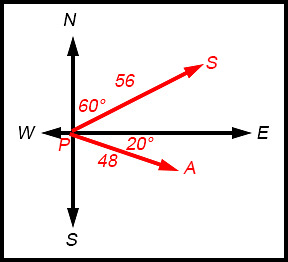
|
(ii) Check the diagram: We know one angle
|
Three ships start from Port O.
Answer.(ii) AB = 72 nm. (ii) Bearing of C from B is 338°T. |
||
The diagram below shows three towns, A, W and B. A plane travelling from town A to town B must make a stop-over at town W. Town W is 120 km on a true bearing of 312° from town A. Town B, which is directly north of town A, is on a true bearing of 042° from town W.
Answer.(ii) 253 - 179 = 74 km. |
||
17. A course for a Championship Drone event requires competitors to fly from point A on a bearing of 050° for 1.2 km over cliffs with significant updrafts to point B. From point B they must then fly on a bearing of 230° over land for 2.8 km to point C.
|
||
18. |
||
| (i) ESE = 22.5° below direct east. So the true bearing is 90° + 22.5° = 112.5° |
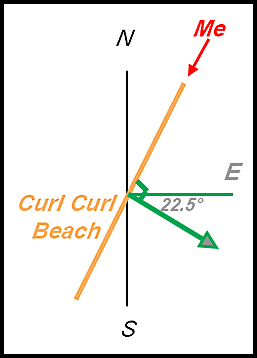 |
|
(ii) Looking at me from the beach requires looking 22.5° from North. Hence the bearing to me FROM the beach is 22.5°.
|
 |
|
(iii) From my position, I am looking 22.5° further than due South along the beach. Hence the beach FROM my position is: This is the same as S22.5°W. |
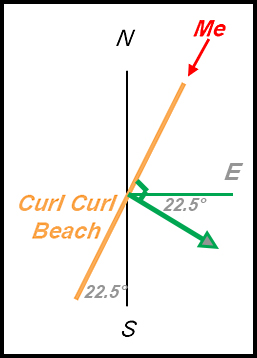 |
|
